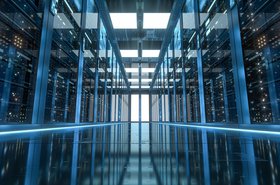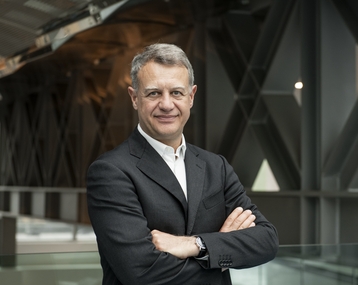For every data center operator, moving to sustainable practices and clean energy sources isn’t a matter of “if” but “when.”
Some may have already made the switch, whilst others are at the planning stage. But then there’s a third group. A group that is aware of the impending need to comply with corporate goals, regional regulations, and national laws, but doesn’t know where to start.
That’s why it’s essential to pick a partner with the expertise to shepherd your journey to a cleaner future.
DCD spoke to Fabrizio Landini, global data center segment leader at Hitachi Energy about the pros and pitfalls of becoming a green facility, and how with the proper support, it can be both easier and cheaper than you may think.
“The important thing to remember is that Net Zero is a journey, not just a destination,” explains Landini.
“The journey may have many routes, and the destination depends on your climate goals and your business needs. Net Zero comes in many ways.”
One of the most critical tools is the ability to measure your carbon emissions, both at the outset and continually as changes are made to the way each facility is run, adding more green solutions and subtracting carbon. It’s a metaphorical map of the road to a clean data center, telling you where you are, where you came from, if you’re going the right way, and more importantly, if you’ve taken any wrong turns.
As Landini says: “It’s difficult to understand if you’re heading towards a sustainable result unless you can identify what emissions you’re creating. By leveraging carbon measurement and calculator tools, for instance, Hitachi customers have the visibility to see what they’ve done and what is left to do.”
“Furthermore, Hitachi Energy is strategically developing hydrogen as a clean alternative to traditional fossil fuels, but that’s just part of the journey," says Landini.
“We take a holistic approach to making the data center industry greener,” he explains. “That’s why our portfolio isn’t siloed – it stretches across all our verticals. After all, it’s not enough to fit a hydrogen generator if it’s not part of an overall package of measures. It’s also vital to look at the entire lifecycle of the data center – from design to build, to use, to expansion, through to decommissioning.”
But what is it about hydrogen that makes it such an exciting prospect?
“The appeal of hydrogen is that the tech is ready, today. There are a lot of proposed solutions for cleaner energy, but many of them are hindered by an underdeveloped supply chain or are simply too much in their infancy. Hydrogen technology is mature, can be cost-effective over its lifespan and its only by-product is water. What we need to address as an industry is the ‘case at scale’.”
Another area that Landini champions is the microgrid, a dedicated electrical grid system for the facility it powers.
Microgrids themselves are nothing new, offering a better way for data centers to generate and use power at high voltages without relying on the conventional or “macro” grid. However, in the age of sustainability, they also provide opportunities to serve the community by feeding excess power back to the local supply, for the benefit of all.
“In the future, data centers will be able to offer themselves as a prosumer provider to the local energy grid, rather than just a consumer. Microgrids will let facilities sell excess generated power to the wider community, while intelligent solutions can collect waste heat and use it to power nearby homes and businesses. It’s not all about changing the power source, it’s also about making the best of what we already have.”
A microgrid can also integrate a battery energy storage system (BESS). While battery technology is still maturing toward its ultimate form, battery arrays can already offer an excellent buffer to peaks and troughs in generation. This is a particular consideration for sources such as wind which are transient in nature. A BESS can also coordinate and leverage the uninterruptable power supply (UPS) battery capacity making it an extremely attractive proposition for locations that depend on truly always-on status.
An overarching theme in creating a green data center is a shift in mindset towards generating green power locally, creating a naturally zero carbon footprint from the outset.
“When we work at a site, we look for solutions that can be integrated at a local level. Locally produced power can be naturally greener and when combined with zero-carbon fuel sources and efficient equipment, it has the potential to reduce emissions to levels below any current legislation, so it's a priority for us to think ‘local’ in everything we do.”
Echoing many potential partners in the data center industry, Landini points out that the secret of making any development a sustainable one on completion is to engage with power-generating partnerships early, ideally at the design stage. This reverts to the idea that sustainability comes from the entire lifecycle of the facility.
“By working with us early on, our customers are able to not only tailor solutions at the design stage but can also get advice on – and adopt – sustainable construction practices. For example, reducing concrete, increasing recycled materials, and future-proofing the fit-out to be ready to keep up with both future advancements and future legislation.”
Once the facility is up and running, your energy partner can help you to stay ahead of the game with performance reviews and regular maintenance to ensure optimal performance and minimal emissions.
Additionally, as new technologies emerge, they can work with you to ensure that the data center is running to the best value proposition targets, increasing efficiency, reducing waste, and maintaining up-time at the levels achieved by traditional fossil fuels.
“There’s no reason why a clean data center should be any less reliable. Energy sources like hydrogen can offer uptime as good as, or better than, traditional ones.”
If all this seems a bit overwhelming, don’t worry. The process can be done in stages with an assessment of existing equipment identifying the biggest polluters and lags to efficiency and thus prioritizing their replacement.
Landini tells us: “Sustainable fuel sources – hydroelectric power, solar, wind and hydrogen fuel cells for example – could be used at highest efficiency into the data center with a direct connection to a direct current (DC) medium voltage bus, as opposed to the alternating current (AC) of standard electricity distribution.
“But even before that, small steps can be taken to find quick wins in your existing setup. For example, by leveraging sustainable grid infrastructure – such as eco-efficient switchgear and transformers – as many Hitachi Energy customers do. And for those further along in their sustainability journey, we enable fast and secure connections to renewable energy sources.”
As Landini concludes, it’s a journey – not a destination. The bulk of that journey can be taken in one go, or in stages, and is only ever complete when the data center is decommissioned. It has many routes, and the map may change during travel.
That’s why it’s important to work with a partner who can offer a bespoke, tailored service that starts and stays with you, throughout every twist and turn – removing the roadblocks, finding optimal routes, checking regularly to see if new avenues have opened up that better suit the destination. Meanwhile, they’re working regularly to check that your shoes aren’t developing holes and you aren’t slowed down by blistered feet.
The message is simple. The journey to Net Zero has begun. It is a journey, yes, but it is within our grasp today. The technology is ready. And it is far better to travel with a learned friend by your side, offering solutions and pathways to decarbonization tailored to your organization’s capabilities, and with the flexibility to take you on the path to net zero.
With an unparalleled installed base in more than 140 countries, Hitachi energy is advancing the world's energy system to be more sustainable, flexible and secure. To find out how Hitachi Energy can support you in your journey towards carbon neutrality, visit hitachienergy.com/data-centers.
More from Hitachi Energy
-

Sponsored What’s in a name?
Hitachi Energy may be a relatively new name in power, but as a company it goes back more than 100 years, as Dave Sterlace explains
-

The power problem and sustainability
Why we need to be smarter
-

DCD>Talks Energy Transition with Dave Sterlace, Hitachi
In this DCD>Talk, live from Connect Virginia, we sit down with Dave Sterlace to explore the move to green energy


